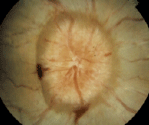 Q: A Medicaid patient presented with papilledema. I finally found a neurologist who would accept her insurance, but the appointment is six weeks from now. How should I handle this?
Q: A Medicaid patient presented with papilledema. I finally found a neurologist who would accept her insurance, but the appointment is six weeks from now. How should I handle this?
A: Papilledema is considered a medical emergency, regardless of the patients insurance, says Kelly Malloy, O.D., director of the Neuro-Ophthalmic Disease Clinical Specialty Service at Pennsylvania College of Optometry at Salus University. The patient has to be worked up immediately because of the potentially serious etiologies of papilledema, which include brain tumor, hemorrhage and venous sinus thrombosis.
The patient requires neuro-imaging studiesmagnetic resonance imaging and venographyto look for a venous sinus thrombosis, Dr. Malloy says. If there is no mass lesion noted on the neuro-imaging studies, then the next step is a lumbar puncture. (Imaging must be performed prior to lumbar puncture.) When the lumbar puncture is performed, the cerebrospinal fluid contents need to be analyzed and the opening pressure measured.
This papilledema patient presented with bilateral disc swelling.
Because papilledema is a medical emergency, this can often be handled in a hospital, which can be much more efficient than an outpatient clinic. First, be sure you are dealing with a hospital that has a neurology department on staffdont assume that all do, Dr. Malloy says. Call the hospital and ask for the chief neurology resident or the neurologist on call.

Then, speak with that doctor personally. Dont delegate this to a staff member, Dr. Malloy says. Explain that the patient has papilledema and is in need of the above work-up. The neurologist will then likely decide to admit the patient for this testing.
If you cannot get in touch with a neurologist this way, call the emergency room at the hospital directly. You will probably speak with the charge nurse. Again, explain the situation and the needed work-up. The charge nurse will typically direct you to send the patient to the emergency room.
Whenever you send a patient to the hospital, be sure to give him or her a letter explaining everything that you noted and whom you spoke with at the hospital, because the patient may not initially see the person with whom you spoke on the phone, Dr. Malloy says. A letter that the patient will have in hand helps avoid confusion.
Q: What are some tips that will help me establish a good working relationship with a neurologist?
A: Good communication is the key not only for a good working relationship, but also for prompt and proper patient care. For example, if the patient went to the hospital and her intracranial pressure (ICP) was elevated, but all other testing was negative, she would be diagnosed with pseudotumor cerebri (PTC), Dr. Malloy says. The neurologist would typically prescribe acetazolamide and counsel the patient on the need for weight loss. She would need to be followed by both you and the neurologist in the future.
If you communicate your follow-up findings to the neurologist, the neurologist will be able to modify the patients medication. (Be sure to send along copies of visual fields and disc photos.) Likewise, the neurologists communication back to you is important so that you can be sure that the patient is taking the proper dosage of medication and following the neurologists recommendations.
This communication is key for all patients that you share with a neurologistor any other doctor, for that matter, Dr. Malloy says. The more comfortable the neurologist feels working with you, the more likely he or she will send you new patients that need to be comanaged by an eye doctor, and the more likely the neurologist will make himself or herself available to see your patients who need neurologic care.

